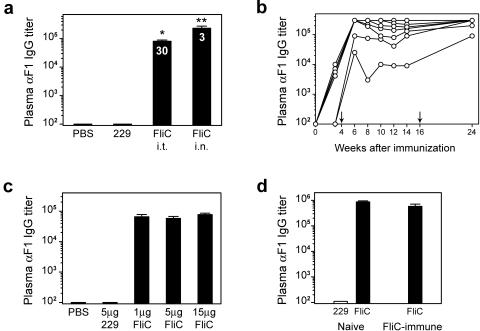FIG. 1.
Immunization with flagellin and the F1 antigen of Yersinia pestis results in substantial anti-F1 antibody production. (a) Female BALB/c mice were immunized i.t. or i.n. with 10 μg F1 plus 1 μg flagellin (FliC). Control animals were immunized i.t. with 10 μg F1 alone or with 1 μg of the 229 mutant flagellin. Mice were boosted in an identical manner at 4 weeks, and plasma was collected 2 weeks later for analysis by ELISA. Numbers within the bars indicate ratio of IgG1/IgG2a isotypes. A single asterisk indicates statistical significance over controls, and a double asterisk indicates that i.n. titers are statistically greater than i.t. (P < 0.007). (b) Anti-F1 antibody titers from mice immunized i.n. with 10 μg F1 plus 1 μg flagellin. Each line represents one mouse, and arrows indicate booster immunizations. (c) Female BALB/c mice were immunized i.t. with 10 μg F1 and increasing amounts of FliC or 5 μg of 229 and boosted at 4 weeks. Plasma anti-F1 IgG titers were determined 2 weeks postboost. (d) A group of female BALB/c mice was immunized i.n. with 5 μg of flagellin alone and boosted in an identical manner at 4 weeks. Anti-FliC antibody titers were determined 2 weeks later (mean anti-FliC titer = 8.5 × 105), and flagellin-immune mice were then immunized and boosted with 10 μg F1 plus 1 μg FliC i.n. Two weeks postboost, anti-F1 titers were determined and compared to titers of flagellin-naive animals immunized with 10 μg F1 plus 1 μg FliC or 229. Bars represent mean antibody titers ± standard errors of the means. Seven female BALB/c mice were used per immunization group.

